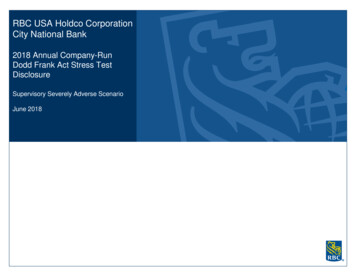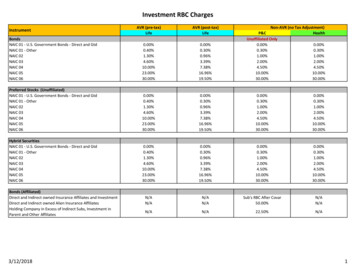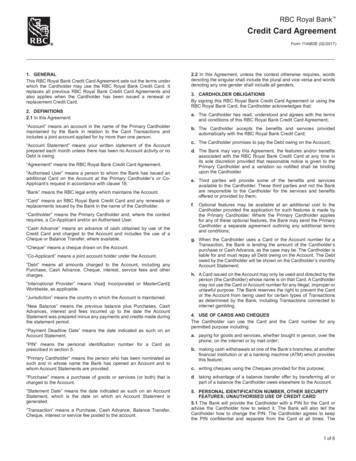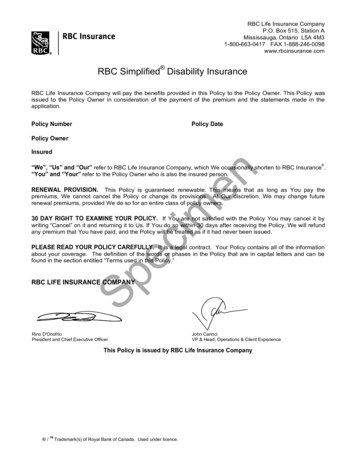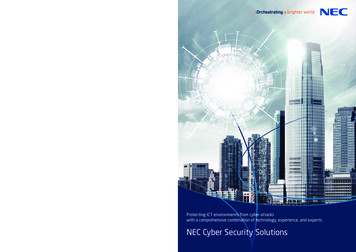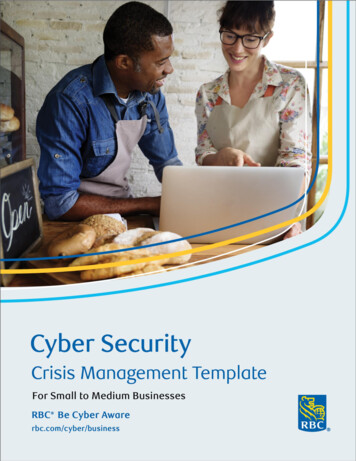
Transcription
Preamble:Since most Small to Medium Sized Businesses (SMB’s) have difficulty implementing propersecurity practices – either due to a lack of funds or resources – they are highly targeted as victims ofcyber-attacks. Often a single cyber event can be damaging to an SMB by creating irreparablereputational/monetary loss, or even leading to disbandment. This documentation is intended to helpclose the gap between adequate cyber security practices and SMB’s by offering the foundations toproper crisis management and the steps to recovery if a cyber-attack were to occur.Disclaimer:The information contained in this document is for general guidance and informational purposes only and it may not be accurate orcomplete, nor does it constitute legal or other professional advice. This template describes common practices and suggestions which maynot be relevant or appropriate in every case. Readers should not consider any advice or guidance contained within this template ascomprehensive and/or all encompassing. The contents are not meant as a substitute for legal, cyber security or other professional advice,and should not be relied upon as a complete analysis of the subject matter discussed. Readers seeking further guidance should consult acybersecurity professional for specific advice about their cybersecurity program and its cyber security incident management plans. Allrisks related to the cyber security of information technology systems are the responsibility of system owners. No responsibility or liability isor will be accepted by RBC or its affiliates as to or in relation to the accuracy or completeness of the information contained in thisdocument. All rights reserved.RBC Cyber Security Crisis Management TemplatePage 2
Incident Response: Crisis Management PlanningConsidering the possibility of a cyber event: where an organization’s assets or informationsystems are exploited, tampered with, or left inaccessible, it’s critical for SMB’s to have astructured plan of action in order to respond as efficiently as possible. To ensure preparedness for acyber event, SMB’s should look to create a Crisis Management Standard, an index of policiesfor approaching cyber events, by following the procedures described below:Foundations & Pre-Planning Policies for Crisis ManagementCyber Event CategorizationThe only way for an organization to handle a cyber event is to adequately prepare ahead of time.SMB’s should consider what events might have an impact on their organization and their level ofharm if acted upon. The below is provided as an insight for how cyber events are categorized; thisform should be adapted to fit the unique cyber events that the organization implementing a crisismanagement standard could face. The severity level that a cyber event could pose to a SMB issubjective and could differ from the severity levels identified below. Make sure you tailor the CyberEvent Categorization chart to your specific SMB.Incident Types Examples:Indication of Cyber EventExampleEngagement ProcedureSeverity LevelLost DeviceEmployee loses laptop ormobile device or tokenLowTarget of Malpractices:The organization is the targetof a phishing or vishingcampaignMediumSystem DisruptionDisruption of OrganizationalSystems (Denial of ServiceAttack)HighCredentials CompromisedExecutive Credentials arecompromised with access tosensitive information orpayment authoritiesHighInability to access InformationImportant organizationalinformation is left inaccessibledue to encryption malwareCriticalOrganizational records andinformation are found outside ofthe organizationCriticalonline or by phone(Ransomware)Data BreachRBC Cyber Security Crisis Management TemplatePage 3
Communication with StakeholdersA Stakeholder is any entity that is affected by an event, either by impact or provided service. Stakeholdercommunication is a critical area of crisis management that bolsters an organization’s ability to respond to acyber event. Below is a template designed to help guide the process of identifying stakeholders within anorganization to best define proper contact, method of contact and the organization's fast response in thepossibility of a cyber event.IT Stakeholders:PositionNamePrimary Contact Info.DepartmentNote: IT Stakeholders should account for key technology-based contacts that workwithin or to service the organization. (Examples: CTO, Service Vendors, ITDepartment, etc.)Non-IT Stakeholders:RoleNamePrimary Contact Info.DepartmentNote: Non-IT Stakeholders are internal employees, governing bodies and keypoints of internal contact, as well as third party points of contact that provide aservice to the organization. (Examples: Legal, Accounting, Human Resources,Public Affairs, etc.)RBC Cyber Security Crisis Management TemplatePage 4
Constructing an Engagement ProcedureThe engagement procedure is the centerpiece to any crisis management template, detailing how theorganization wishes to deal with cyber events of a specific nature and clearly defining goals, strategy and scopeof the procedure. Organizations should work to expand upon the pillars of the below engagement procedureto better fit the requirements for a proper response.Mission Statement: What is the goal?Example: Mitigating Loss of Organizational HardwareContaining Business information (Lost Device.)Scope of Plan: What areas of the organization areExample: Employee Line of Business (L.O.B) and anyimpacted?corresponding parties.Organizational Strategy: How is the organizationExample:intending to return to normal business functionality?- Temporarily disable employee account access and requirecredential changes.- Address possible information loss following organizationdata loss policies & procedure.Communications: How do we address impacted parties?Example: Follow Communication Policies and standards toimpacted parties.Note: SMB’s should take into consideration the resources they have, their functionand assets to provide a plan that meets the unique requirements for response to acyber event.RBC Cyber Security Crisis Management TemplatePage 5
Communications TemplateAddressing impacted parties, stakeholders and key users for awareness is an important step tocrisis management. To best advise these groups, it's recommended that SMB's provide anadequate level of information to end-users without compromising the specifics of a cyber event. Ata certain point, to be determined by each SMB, it may become necessary to fully communicate thehappenings of a cyber event. The timing of communications and the amount of informationdisclosed, including notification to any governing bodies, should be thought out in advance and preplanned.General Alerting: Current Date & TimeServices effected: What function of the organization is currently out of operation and who isimpactedNature of the Outage: Brief description of cause (eg. System X is down, Data XYZ cannotbe accessed). You do not need to refer to the specific cyber event itself in this general alertTime/date of service restoration: Estimated time to regain business operationRBC Cyber Security Crisis Management TemplatePage 6
Crisis Management Policies – Pulling it All TogetherBy following the completion of the above templates as the foundation of crisis management, theorganization can create effective management policies based on: Cyber Event Categorization: A prioritized list of possible cyber events unique to theorganization.Key Stakeholder Identification: Key contact information, both technical and non-technicalpersons in the event their services or contact is needed.Engagement Procedure: The organization’s plan in response to a cyber event, detailing howevents will be handled and communicated.Communications Template: A communications template used to address impacted parties.SMB’s should employ the above documentation relative to the perceived cyber event in order toanswer the following prompts: What happened? What is the impact? What is our plan? How are we communicating?These questions broadly detail each step to handling a cyber event from initial recognition toresolution. Policy creators should position themselves from the perspective of an employee trying toutilize a crisis management plan, to ensure the needs from the policy are being met. Below is anexample of how these questions, paired with the above documentation can be employed to provide aneffective plan of response.RBC Cyber Security Crisis Management TemplatePage 7
Example Documentation of a Crisis Management PolicyCrisis Management – Lost Organizational Device *LOW*IT StakeholdersPositionNamePrimary Contact Info.DepartmentAccess ManagerJohn Doe(555) 555-1234Access ManagementDevice ProvisionerJane Doe(555) 555-9876Device ProvisioningPositionNamePrimary Contact Info.DepartmentHuman ResourcesJoan Doe(555) 555-4334Human ResourcesCommunications LeadJoanne Doe(555) 555-2317CommunicationsEmployee L.O.B*Please Specify**Please Specify**Please Specify*Non-IT StakeholdersConsultantEngagement ProcedureMission Statement:Mitigating Loss of Organizational Hardware Containing Business information (LostDevice)Scope of Plan:Organizational Strategy:Employee Line of Business (L.O.B) and any corresponding parties. Temporarily disable employee account access and require credential changes. Address possible information loss following organization data loss policies &procedure.Communications:Follow communication policies and standards to impacted partiesCommunications Strategy:Contacts: Access Management, Employee L.O.B, Impacted PartiesCommunications Standard: Priority: LowSubject: “Message to Impacted Parties: Lost Device”Body of Message: An organizational device has been reported missing, please followorganization standards to prevent further data loss.Contact Names:- HR Consultant: Joan Doe - (555) 555-4334- Access Manager: John Doe – (555) 555-1234Reminder of Privacy, including Social Media: *Privacy reminder* / Trademark(s) of Royal Bank of Canada.RBC Cyber Security Crisis Management TemplatePage 8
RBC Cyber Security Crisis Management Template P a g e 5. Constructing an Engagement Procedure . The engagement procedure is the centerpiece to any crisis management template, detailing how the organization wishes to deal with cyber events of a specific nature and clearly defining goals, strategy and scope of the procedure.


